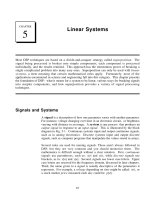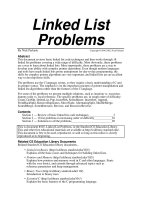Linear List Concepts
Bạn đang xem bản rút gọn của tài liệu. Xem và tải ngay bản đầy đủ của tài liệu tại đây (589.6 KB, 71 trang )
Linear List Concepts
List ADT
Specifications for List ADT
Implementations of List ADT
Contiguous List
Singly Linked List
Other Linked Lists
Comparison of Implementations of List
Chapter 2 – LIST
1
DEFINITION: Linear List is a data structure where
each element of it has a unique successor.
Linear List Concepts
element 1 element 2 element 3
2
Linear List Concepts (cont.)
3
Linear List Concepts (cont.)
General list:
• No restrictions on which operation can be used
on the list
• No restrictions on where data can be
inserted/deleted.
Unordered list (random list): Data are not in
particular order.
Ordered list: data are arranged according to a
key.
4
Linear List Concepts (cont.)
Restricted list:
• Only some operations can be used on the list.
• Data can be inserted/deleted only at the ends
of the list.
Queue: FIFO (First-In-First-Out).
Stack: LIFO (Last-In-First-Out).
5
List ADT
DEFINITION: A list of elements of type T is a finite
sequence of elements of T together with the
following operations:
Basic operations:
• Construct a list, leaving it empty.
• Insert an element.
• Remove an element.
• Search an element.
• Retrieve an element.
• Traverse the list, performing a given operation on each
element.
element 1
. . .
element 2 element 3 element n
6
List ADT (cont.)
Extended operations:
• Determine whether the list is empty or not.
• Determine whether the list is full or not.
• Find the size of the list.
• Clear the list to make it empty.
• Replace an element with another element.
• Merge two ordered list.
• Append an unordered list to another.
• …
7
Insertion
Insert an element at a specified position p in the
list
Only with General Unordered List.
Insert an element with a given data
With General Unordered List: can be made at any position
in the list (at the beginning, in the middle, at the end).
With General Ordered List: data must be inserted so that
the ordering of the list is maintained (searching appropriate
position is needed).
With Restricted List: depend on it own definition (FIFO or
LIFO).
8
Insert an element at a specified position p in the list.
Before:
After:
Any element formerly at position p and all later have their position
numbers increased by 1.
Insertion (cont.)
30 60 50
...
4020
...
10
1 p-2 p-1 p n+1p+1
60
30 10 50
...
4020
...
1 p-2 p-1 p n
9
Removal, Retrieval
Remove/ Retrieve an element at a specified position p
in the list
With General Unordered List and General Ordered List.
Remove/ Retrieve an element with a given data
With General Unordered List and General Ordered List:
Searching is needed in order to locate the data being
deleted/ retrieved.
10
Remove an element at a specified position p in the list.
Before:
After:
The element at position p is removed from the list, and all
subsequent elements have their position numbers decreased
by 1
Removal
...
...
11
30 10 50 4020
1 p-2 p-1 p n
30 60 50
...
4020
...
10
1 p-2 p-1 p n+1p+1
...
Retrieve an element at a specified position p in the list.
Before:
After:
retrieved data = 60
All elements remain unchanged.
Retrieval
30 60 50
...
4020
...
10
1 p-2 p-1 p n+1p+1
30 60 50
...
4020
...
10
1 p-2 p-1 p n+1p+1
12
Success of Basic Operations
Insertion is successful when the list is not full.
Removal, Retrieval are successful when the list is
not empty.
13
Specification for List ADT
<void> Create()
<void> Traverse (ref <void> Operation ( ref Data <DataType>) )
<ErrorCode> Search (ref DataOut <DataType>) // DataOut contains
values need to be found in key field, and will reveive all other values
in other fields.
// For Unsorted List:
<ErrorCode> Insert (val DataIn <DataType>, val position <integer>)
<ErrorCode> Remove (ref DataOut <DataType>,val position <integer>)
<ErrorCode> Retrieve (ref DataOut <DataType>,val position <integer>)
<ErrorCode> Replace (val DataIn <DataType>,
ref DataOut<DataType>, val position <integer>)
(Operations are successful when the required position exists).
14
Specification for List ADT (cont.)
// For Sorted List:
<ErrorCode> Insert (val DataIn <DataType>)
<ErrorCode> Remove (ref DataOut <DataType>) // DataOut contains
values need to be found in key field, and will reveive all other values
in other fields.
<ErrorCode> Retrieve (ref DataOut <DataType>) // DataOut contains
values need to be found in key field, and will reveive all other values
in other fields.
(Insertion is successful when the list is not full and the key needs to be
inserted does not exist in the list.
Removal and Retrieval are successful when the list is not empty and the
required key exists in the list).
15
Specification of List ADT (cont.)
Samples of Extended methods:
<boolean> isFull()
<boolean> isEmpty()
<integer> Size()
<ErrorCode> Sort ()
<ErrorCode> AppendList (ref ListIn <ListType>) // For Unordered Lists.
ListIn may be unchanged or become empty.
<ErrorCode> Merge (ref ListIn1 <ListType>, ref ListIn2 <ListType>)
// For Ordered Lists.
. . .
16
Specification of List ADT (cont.)
Samples of variants of similar methods:
<void> Create()
<void> Create (ref file <InOutType>) // made a list from content of a file
<ErrorCode> Insert (val DataIn <DataType>, val position <integer>)
<ErrorCode> InsertHead (val DataIn <DataType>)
<ErrorCode> InsertTail (val DataIn <DataType>)
<ErrorCode> Replace (val DataIn <DataType>,
ref DataOut <DataType>, val position <integer>)
<ErrorCode> Replace (val DataIn <DataType>,
ref DataOut <DataType>)
17
Specification of List ADT (cont.)
Samples of variants of similar methods:
<ErrorCode> Remove (val position <integer>)
<ErrorCode> Remove (ref DataOut <DataType>,
val position <integer>)
<ErrorCode> RemoveHead (val DataOut <DataType>)
<ErrorCode> RemoveTail (ref DataOut <DataType>)
<ErrorCode> Search (val DataIn <DataType>, ref ListOut <ListType>)
// DataIn contains values need to be found in some fields, ListOut
will contain all members having that values.
. . .
18
Implementations of List ADT
Contiguous implementation:
Automatically Allocated Array with fixed size.
Dynamically Allocated Array with flexible size.
Linked implementations:
Singly Linked List
Circularly Linked List
Doubly Linked List
Multilinked List
Skip List
. . .
Linked List in Array
19
0 1 2 3 n-2 n-1 max-2 max-1 max
Array with pre-defined maxsize and has n elements.
List // Contiguous Implementation of List
count <integer> // number of used elements (mandatory).
data <array of <DataType> > // (Automatically Allocated Array)
End List
Automatically Allocated Array
x x x x xx
n
count
data
…
…
20
Dynamically Allocated Array
0 1 2 3 n-2 n-1 max-2 max-1 max
List // Contiguous Implementation of List
count <integer> // number of used elements (mandatory).
data <dynamic array of <DataType> > // (Dynamically
Allocated Array)
maxsize <integer>
End List
21
x x x x xx
n
count
data
…
…
max
maxsize
Sample of using List ADT
#include <iostream>
#include <List> // uses Unordered List ADT.
int main()
{ List<int> listObj;
cout << "Enter 10 numbers: \n" <<flush;
int i, x;
for (i=0; i<10; i++)
{ cin >> x;
listObj.Insert( x, listObj.Size() ); // Insert at the end of the list.
}
cout << "Elements in the list: \n";
for (i=0; i<10; i++)
{ listObj.Retrieve(x, i);
cout << x << "\t";
}
return 0;
}
22
Contiguous Implementation of
List
In processing a contiguous list with n elements:
• Insert and Remove operate in time approximately
proportional to n (require physical shifting).
• Clear, Empty, Full, Size, Replace, and Retrieve in
constant time.
23
Singly Linked List
Singly Linked List
List // Linked Implementation of List (for Singly Linked List)
head <pointer>
count <integer> // number of elements (optional).
End List
head
…
head
data link
24
head
count
An empty Singly Linked List
having only head.
An empty Singly Linked List
having head and count.
0
Singly Linked List (cont.)
Node
data <DataType>
link <pointer> Element in the Singly Linked List
End Node
General DataType:
DataType
key <KeyType>
field1 <…>
field2 <…>
…
fieldn <…> DataType may be an atomic or a composite data
End DataType
data link
25









